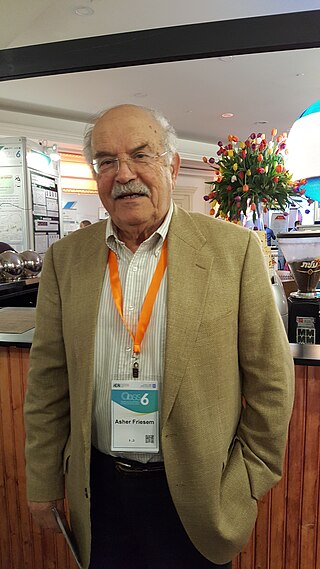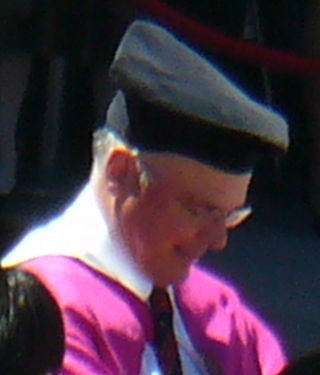Related Research Articles

Nader Engheta is an Iranian-American scientist. He has made pioneering contributions to the fields of metamaterials, transformation optics, plasmonic optics, nanophotonics, graphene photonics, nano-materials, nanoscale optics, nano-antennas and miniaturized antennas, physics and reverse-engineering of polarization vision in nature, bio-inspired optical imaging, fractional paradigm in electrodynamics, and electromagnetics and microwaves.
Xi-Cheng Zhang is a Chinese-born American physicist, currently serving as the Parker Givens Chair of Optics at the University of Rochester, and the director of the Institute of Optics. He is also the Chairman of the Board and President of Zomega Terahertz Corporation.

Asher A. Friesem is a professor at the Weizmann Institute of Science in Israel.
Robert Earl Hopkins was president of the Optical Society of America in 1973.

Robert Louis Byer is a physicist. He was president of the Optical Society of America in 1994 and of the American Physical Society in 2012.
Anthony J. DeMaria is an American researcher in lasers and their applications, particularly known for his work with picosecond laser pulses.
Eric Van Stryland was president of the Optical Society of America in 2005.

Anthony Michael Johnson is an American experimental physicist, a professor of physics, and a professor of computer science and electrical engineering at the University of Maryland, Baltimore County (UMBC). He is the director of the Center for Advanced Studies in Photonics Research (CASPR), also situated on campus at UMBC. Since his election to the 2002 term as president of the Optical Society, formerly the Optical Society of America, Johnson has the distinction of being the first and only African-American president to date. Johnson's research interests include the ultrafast photophysics and nonlinear optical properties of bulk, nanostructured, and quantum well semiconductor structures, ultrashort pulse propagation in fibers and high-speed lightwave systems. His research has helped to better understand processes that occur in ultrafast time frames of 1 quadrillionth of a second. Ultrashort pulses of light have been used to address technical and logistical challenges in medicine, telecommunications, homeland security, and have many other applications that enhance contemporary life.
Demetri Psaltis is a Greek-American electrical engineer who was the Dean of the School of Engineering at École Polytechnique Fédérale de Lausanne from 2007 to 2017. Since 2024 he is a professor emeritus at EPFL. He is one of the founders of the term and the field of optofluidics. He is also well known for his past work in holography, especially with regards to optical computing, holographic data storage, and neural networks. He is an author of over 1100 publications, contributed more than 20 book chapters, invented more than 50 patents, and currently has a h-index of 104.
James Clair Wyant was a professor at the College of Optical Sciences at the University of Arizona where he was Director (1999–2005) and Dean (2005–2012). He received a B.S. in physics from Case Western Reserve University and M.S. and Ph.D. in optics from the Institute of Optics at the University of Rochester.
Christopher Dainty is a professor who researches optical imaging, scattering and propagation. In these areas he has published books: Scattering in Volumes and Surfaces, Laser Speckle and Related Phenomena and Image Science (1974) which he co-authored with Rodney Shaw. He has co-authored around 170 peer-reviewed papers and some 300 conference presentations.
John Michael Dudley is a physicist and currently Professor of Physics at the University Bourgogne Franche-Comté working at the joint University-CNRS research Institute FEMTO-ST in Besançon, France. Originally from New Zealand, he is known for his research in nonlinear and ultrafast optical physics, for service to international scientific societies, and for initiatives in promoting international scientific outreach and the public communication of science.

Paul F. McManamon is an American scientist who is best known for his work in optics and photonics, as well as sensors, countermeasures, and directed energy.

David A. B. Miller is the W. M. Keck Foundation Professor of Electrical Engineering at Stanford University, where he is also a professor of Applied Physics by courtesy. His research interests include the use of optics in switching, interconnection, communications, computing, and sensing systems, physics and applications of quantum well optics and optoelectronics, and fundamental features and limits for optics and nanophotonics in communications and information processing.
Edmund Y. Lam is a Chinese professor and associate dean of engineering at the University of Hong Kong.
Byoungho Lee was a South Korean scientist best known for his work on three-dimensional displays and nanophotonics. From 1994 until his death, he was on the faculty of the School of Electrical and Computer Engineering of Seoul National University. He and his research group published more than 400 peer-reviewed international journal papers, more than 700 international conference papers, and more than 20 books and book chapters. His accumulated citations are over 23,000 and his h-index is 75. At the time of his death, he was the dean of the Engineering College of Seoul National University.
James J. Coleman is an electrical engineer who worked at Bell Labs, Rockwell International, and the University of Illinois, Urbana. He is best known for his work on semiconductor lasers, materials and devices including strained-layer indium gallium arsenide lasers and selective area epitaxy. Coleman is a Fellow of the IEEE and a member of the US National Academy of Engineering.

Mona Jarrahi is an Iranian Engineering professor at the University of California, Los Angeles. She investigates novel materials, terahertz/millimeter-wave electronics and optoelectronics, microwave photonics, imaging and spectroscopy systems.
Pericles A. Mitkas is a Greek university lecturer in electronic and computer engineering. He holds American as well as Greek nationality and is Rector of the Aristotle University of Thessaloniki (AUTH). He was elected as President of both the Black Sea Universities Network and the Balkan Universities Network from 2018 to 2020.
Peter J. Delfyett Jr is an American engineer and Pegasus Professor and Trustee Chair Professor of Optics, ECE & Physics at the University of Central Florida College of Optics and Photonics.
References
- 1 2 Joseph W. Goodman at the Mathematics Genealogy Project
- ↑ "Resume- Joseph W. Goodman". Stanford University.
- ↑ Articles Published by early OSA Presidents Archived 2015-03-20 at the Wayback Machine Journal of the Optical Society of America
- ↑ "Past Presidents of the Optical Society of America". Optic Society of America. Archived from the original on 2009-01-20.
- 1 2 3 4 5 6 7 8 "Resume- Joseph W. Goodman". Stanford University.
- ↑ "IEEE James H. Mulligan, Jr. Education Medal Recipients" (PDF). IEEE. Retrieved November 24, 2010.